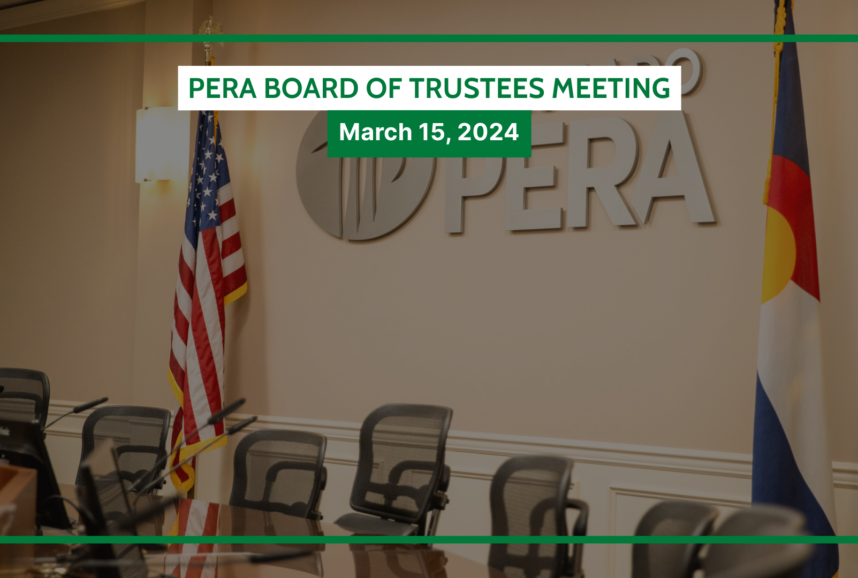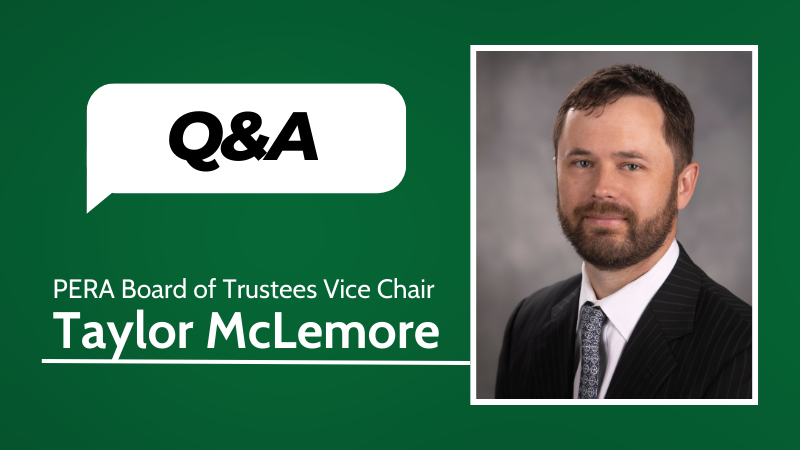In late November, the PERA Board of Trustees voted to lower PERA’s expected investment rate of return to 7.25 percent from 7.5 percent and adopt new mortality tables. These changes will increase the amount of time for PERA to become fully funded (read more about determining PERA’s funded status here and the news release here).
The Board took action after a rigorous review process that started in September and included an experience study of what had actually happened in each Division’s fund, along with input from economic, investment, and actuarial experts. The adoption of new mortality tables and the lowered rate of return will result in extending PERA’s amortization period.
In October 2015, the Colorado Office of the State Auditor released a report authored by Pension Trustee Advisors (PTA) to the General Assembly’s Legislative Audit Committee. This analysis looked at the various components used in determining PERA’s financial health. The PTA analysis included a signal light methodology designed to expand how PERA reports on its funded status as well as the likelihood of achieving its full funding objectives.
In 2016, PERA implemented the signal light methodology as part of its 2015 financial reporting. The methodology showed that all of PERA’s five division trust funds are sustainable and on a path to full funding. However, the Judicial Division is in the “orange” signal light category, indicating steps should be taken to reduce the amortization period of this small Division.
It is important to note, factoring in the changes made to actuarial and economic assumptions by the Board in November 2016, the trusts are not projected to run out of money as was the case before the 2010 reform legislation was enacted.
What are the next steps?
In November, the PERA Board charged PERA staff with convening broad-based conversations throughout the State of Colorado regarding PERA’s financial condition and serving as the trusted resource for stakeholders and policy makers statewide.
PERA will know more about the extension of the amortization period for each Division’s trust and the impact of the Board’s assumption changes in January after PERA’s actuaries finish their work. While the full extent of the impacts from these assumption changes is still being determined, it is clear that PERA is fully sustainable and will continue to pay benefits throughout the period it takes to reach 100 percent funded. The Board continues to be committed to making difficult and complex decisions in the best interest of PERA members, and will take a measured approach to ensure PERA is on the path to becoming fully funded in a reasonable period of time and remains one of Colorado’s best investments.
PERA on the Issues posts are written and compiled by the staff of Colorado PERA under the direction of Executive Director Greg Smith and the PERA Board of Trustees. We encourage you to comment with your thoughts and feedback.
Trust fundA fund in which money and/or other assets are held and managed by trustees on behalf of plan participants. PERA maintains trust funds for each of its Defined Benefit Plan divisions (State, Local Government, School, Denver Public Schools, and Judicial).AmortizationThe act of paying down debt or liabilities over time.





How is PERA directly engaged with the Legislature to make sure that these two changes will be addressed with necessary additional funding in order to reach a more acceptable funded status (80%+) with a fully funded status in a reasonable time period?
Mr. Enright,
Thank you for your question. The PERA Executive Team meets regularly with legislative leadership and legislators. Once PERA’s actuaries have provided a complete picture to the Board in January of the impact of the assumption changes, we will be further engaging all of PERA’s stakeholders.
Thank you for your prompt response. As the Legislators and the JBC are stakeholders that would have the greatest impact on any funding changes, I hope that PERA’s efforts are successful. Please continue to keep members informed of specific activities and legislation efforts related to necessary funding.
My x draws over $200,000 per year from PERA. His wife draws less, but quite a good sum. After being paid a huge salary for years, such a large pension is ridiculous. There should be a limit on what one can draw from a PERA retirement. Certainly not over $100,000, and even that is excessive.
Dear Ann,
Thank you for your suggestion. For individuals who became PERA members after 1996, the maximum annual salary subject to pension contributions is $262,000. At the end of 2015, there were 18 retirees receiving a PERA retirement benefit of more than $200,000 (out of 110,000 retirees). The median annual benefit in 2015 was about $35,000. For more details on PERA benefit payments, please see our fact sheet here: https://www.copera.org/sites/default/files/documents/5-140.pdf
How much would actuarial assumptions and/or investment yield projections have to worsen, indicating deeper or more prolonged underfunding, before the new signal system flashes red and requires (a) increased contributions by PERA employers and/or members, (b) reduced or delayed benefits relative to those specified in the 2010 bill, or some combination of the two?
Mr. Deane,
In the PTA analysis (link in the body of the post above on page 56), the Red and Dark Red categories are defined as “RED: Plan is anticipated to become insolvent between 2035 and 2055, or technically insolvent because it falls below 20% funded before 2065. DARK RED: Plan is anticipated to become insolvent by 2035.” PERA does not anticipate this to be the case when the actuaries report to the Board of Trustees in January.